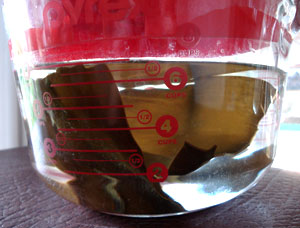
As I've stated many times here over the years, the basis of most Japanese savory foods is a good dashi, or stock. Dashi is not just used for soups, it's used for stewing, in sauces, batters, and many, many other things.
The regular way to make dashi was one of my first entries on Just Hungry. It uses kombu seaweed and dried bonito flakes (katsuobushi). Some people use niboshi, small dried fish, in addition to or instead of bonito flakes.
Katsuobushi and niboshi are both fish-based, so not vegetarian. So how do you make a good vegetarian, even vegan, dashi?
Filed under:
basics japanese soup vegetarian vegan
Submitted by maki on 14 May, 2007 - 17:18
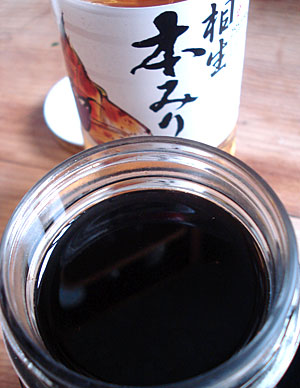
When the weather gets warmer, we eat a lot of cold Japanese noodles: soba (buckwheat noodles), hiyamugi (thin wheat noodles), so-men (even thinner wheat noodles), Sanuki udon (thick wheat noodles- Sanuki is the name of a region famous for udon) and harusame (bean or 'glass' noodles). For most cold noodle dishes a salty sweet soy sauce based soup or dipping sauce called mentsuyu is used. You can buy pre-made mentsuyu concentrate, but to me most of them taste too sweet or are overwhelmed by a too-strong MSG or similar artificial tasting umami flavor. Making mentsuyu at home from scratch is not so difficult, and the difference in taste is quite worth the little extra effort.
The base of mentsuyu is a mixture of soy sauce, sugar and mirin called kaeshi (or hon-gaeshi: hon means "real" or "authentic"). It can also be used as a flavoring base for many other things. You just need good quality dark soy sauce, white sugar, and good quality mirin. It keeps for months in the refrigerator, or even in the freezer (where it will stay liquid) so I like to make as big a batch as I can afford to price-wise and fridge-space-wise.
This is similar to the Japanese essence mix, but doesn't include the kombu seaweed or bonito. If you are a vegetarian you can use kaeshi safe in the knowledge that it's totally vegan, and combine it with a vegetarian stock. Kaeshi also lasts a lot longer since the basic ingredients are indefinite keepers.
I'll be talking about cold noodles and such in upcoming posts, so if you'd like to follow along, you may want to make some kaeshi to be ready.
This is a very traditional basic recipe.
Type:
recipe Filed under:
basics japanese sauce noodles
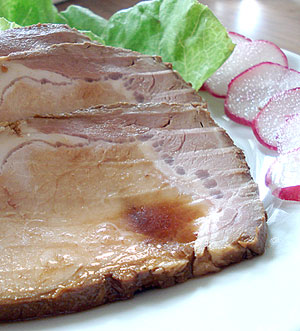
With summer just around the corner, I like to think of food that can be made well ahead and tastes great served cold, or at least cool, to keep me out of a hot kitchen. The vegetable part of this is usually taken care of with seasonal vegetable salads and the like. If the protein part means meat, I like to have pre-cooked pieces tucked away in the freezer.
One of my favorite cold meats is poached and marinated pork, or nibuta. (Ni means to cook in liquid, and buta is pig.) It's very easy to make, stores beautifully in the refrigerator for about a week or much longer in the freezer, and of course, tastes great - savory, slightly sweet, and very juicy. It can be sliced very thinly or julienned for one-dish meal salads or in sandwiches, or chopped up and added to stir-fries, wraps, and so on. It's a great addition to a bento box. It can be cubed or coarsely ground and used instead of char siu (roast pork) in steamed buns or bao. The possibilities are only limited by your imagination.
There's one unusual 'secret ingredient' in the poaching liquid, umeboshi or pickled plum. You can omit this if you like, but adding just one umeboshi seems to de-fat the meat a bit more than just poaching, plus making it taste a bit cleaner and fresher in an interesting way.
Filed under:
basics japanese weekend project summer pork meat
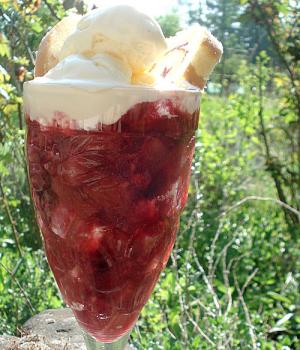
On rhubarb, stewed fruit and England
I first saw this curious plant called rhubarb during the time we lived for 5 years in Berkshire, England. I was 5 when we moved there. The rhubarb grew like a small jungle in a corner of the vegetable patch of the house we were renting, alongside some equally puzzling gooseberry bushes. Neither existed at all in Japan at the time, and my mother was at a loss as to what to do with them, until our next door neighbor lady told her how to stew them. The neighbor lady believed in stewing most fruit - she told my mother to stew or jam all of the raspberries too, since eating them raw may lead to upset small tummies. Thankfully my mother didn't take her advice for all of the raspberries, and I still have memories of stickily enjoying bowls and bowls of red, ripe raspberries with clouds of whipped cream. One of the first things I did when I got my own garden was to plant several raspberry canes.
Stewed and cooked fruit figures quite prominently in my memories of English food at the time. This was in the '70s. Whenever I was invited to tea at a friend's house, there was usually always some sort of cooked fruit dish, be it a compote of peaches in the summer or apple and blackberry pie later on in the year. I think we only ate fresh, raw fruit at home, except for bananas and strawberries. I didn't even know that gooseberries could be anything other than sour, green and only edible stewed with sugar, until I came to Switzerland and saw them left to ripen on a bush, turning a bright reddish-purple.
That penchant for cooking fruit does mean that there are many terrific fruity desserts (aka puddings) in British cookbooks. One of them is trifle. I'm in the midst of my annual rhubarb orgy period, and it's one 'fruit' (though it's botanically a vegetable) that needs to be cooked. Hence, the rhubarb trifle.
The slightly modernized trifle
A trifle is small pieces of sponge cake soaked in a sweet, fruity liquid, and topped with custard or cream. Some versions of trifle are quite alcoholic, but this one has no alcohol in it since I imagine my 8 year old self tucking into it. The components are simple: the fruit-liquidy mix, the cake, and the creamy topping. The key part that makes this trifle different is the rhubarb soaking liquid part, which is quite sour and not too sweet. I've added a few frozen berries (raspberries from last summer's crop in fact) to make the red color more intense - if you have fresh strawberries by all means use those instead.
Trifle is traditionally topped with custard, cream or both. Here I have combined the two so to speak and topped it with vanilla ice cream instead - this is the slightly modernized part. It's homemade but you can use a good store bought ice cream if you don't want to bother, or don't have an ice cream maker.
I think that the key to a good trifle is to not overload it with sponge cake, which makes it go rather stodgy. Add just a few pieces for the interesting texture. Note that I've used pieces of store bought roll cake here (called Swiss roll in England, but not really Swiss as far as I know) which adds some extra flavor. You can assemble it all in a big bowl, or in individual glasses as I've done here.
This is my pre-planned entry for Sam's Fish and Quips event celebrating British food. See also my other two British-theme posts this week, Tasting Guinness Marmite and The Edwardians and their food.
Filed under:
dessert fruit rhubarb spring sweet uk
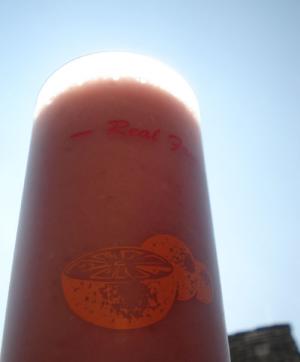
I have a raging cold at the moment. Stuffed head, fever, ringing ears, streaming eyes, the lot. What makes it worse is that the weather is glorious outside, and here I am stuck inside, groaning a lot and feeling sorry for myself.
In times like this the only things I can even think about eating and drinking are fruity yogurt, juices, and tea. This smoothie, which is an adaptation from a recipe in the adorable Innocent Smoothie Recipe Book, combines two of those elements and is tart yet spicy in a nice chest-clearing sort of way. It also tastes wonderful. Although, I'm pretty sure it would taste even better if my mouth didn't feel like cotton wool.
It's a good thing I took this picture against the clear blue spring skies before the cold took over at full steam.
Filed under:
drink fruit rhubarb spring
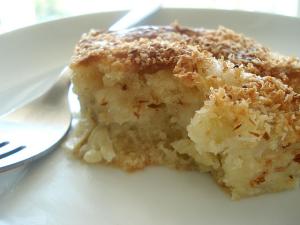
Some recipes come about from long experimentation and several tries to try to perfect them (like those darned bunnies, or my ongoing attempts to make natto at home). Others just seem to happen. We had a bunch of bananas that were rapidly turning very brown and spotty on the kitchen table. I froze some (nothing like frozen bananas as treats), and turned some into a cake.
It's nothing fancy at all - it's basically a pound-cake like base (but with a bit less sugar), with added cut-up bananas. The coconut part was added on a whim also. The cake doesn't rise much, probably because of the bananas, but it's moist, not too sweet, and very comforting. It's perfect with a cup of tea.
So far in my life I've not had the opportunity to go to Hawaii (unless you count a short layover en route from LA to Tokyo) but I sort of imagine that this cake would not be too out of place there.
Filed under:
baking cake quickcook
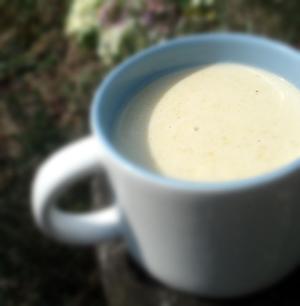
What's the soup of your childhood? The one that your mother made for you when you had a cold, needed cheering up, or just as a treat? For me, there's no question: it's corn cream soup.
Corn cream soup (and yes, it's called like that, not 'cream of corn soup' or 'creamed corn soup') belongs to the _yohshoku_ category of Japanese home cooking. It's an old fashioned, milk based potage, with creamed corn in it. It smells milky, and tastes sweet and savory. It's loved by Japanese kids.
Now, while my mother was a pretty good cook generally, she did have trouble getting some things right. Her curry for instance was always rather watery. And her corn cream soup, instead of being silky smooth, always had little lumps of undissolved roux. I loved those little lumps though - they tasted like tiny dumplings. Later on when I started to make my own corn cream soup I followed recipes, so my corn cream came out smooth and lumpless. That was fine, but I missed the lumps from my childhood memories. So, I incorporated them back.
Everyone uses canned corn to make a corn cream soup. You can be fancy and use fresh, but that lifts this humble soup into the realm of gourmet special-occasion big deal cooking, which is not what my memories are about at all. I have adjusted the usual way of making this soup by using whole corn rather than creamed, since whole corn cans have more actual corn in them and I suspect less added sugar, and I like the mixture of crushed/creamed and whole corn kernels. Besides, creamed corn cans are unheard of here in Switzerland.
Filed under:
japanese soup yohshoku
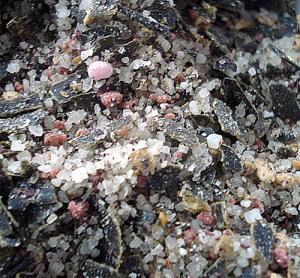
If you browse the aisles of a Japanese grocery, you may run across various instant tsukemono mixes. These come either in liquid or dry form. The dry granules in particular are very handy to have around, and they can make sokuseki zuke in a hurry. However, they usually contain MSG, preservatives and such.
Scouring around the Japanese parts of the interweb, I came across several pages that had recipes for a homemade instant tsukemono mixes, such as this one. They all used MSG or dashi stock granules though, and I wanted to come up with a mixture that was made up 100% of natural ingredients.
After some tinkering around and almost ruining the motor of my food processor, here's the mixture I came up with. To up the umami quotient it has a full 100 grams of finely chopped konbu seaweed in it. It also has some interesting very Japanese ingredients in it such as dried yuzu peel and yukari, dried powdered red shiso leaves.
Filed under:
japanese ingredients vegetarian vegan tsukemono
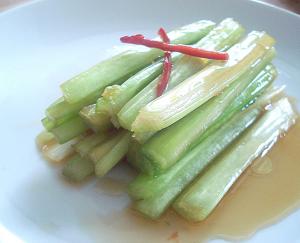
Celery isn't a very Japanese vegetable, but with the addition of the right flavors it can be turned into a refreshingly crunchy pickle that goes well with white rice, which is the base criteria for determining whether a pickle fits a Japanese meal or not. Besides, I always seem to have some celery in my fridge (who doesn't?), and this is a good excuse to use some up.
This is a nice salad-like pickle, that's best eaten with some of the pickling liquid spooned like dressing over the top. There's a nice bite and a color zing from the thin slivers of red chili pepper. (Pirikara means spicy-hot.) There's a little sake and mirin in the dressing, which gives it a twist.
Since celery is more fibrous than cucumber, it needs to marinade for a bit longer. Give it at least 3 hours, or overnight. It doesn't keep too well at room temperature, so reserve this for eating at home. It assembles as quickly as the other quick pickles in this series.
Filed under:
japanese lighter vegetables vegetarian vegan salad tsukemono
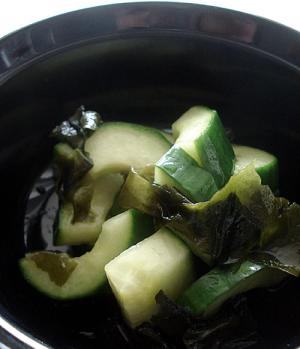
This Japanese sokusekizuke method of letting vegetables marinate in a vinegar-based marinade is similar to Western pickling methods, but there's no canning and sterilation and things involved since these are meant to be eaten within a couple of days like all quick pickles. The vinegar marinade is simply meant to enhance the flavors of the vegetables rather than preserve it for long keeping.
These cucumber pickles are sweet, sour and a bit salty all at the same time. The flavor is quite mild and fresh, so I can eat these several days in a row and not get tired of them. The wakame seaweed can be left out if you prefer, but makes a nice contrast to the cucumber while adding its own umami to the marinade.
The pickles can be eaten anytime from a couple of hours after putting them in the marinade to about 3 days later or so, if you keep it in an airtight container in the refrigerator.
Filed under:
japanese vegetables salad tsukemono
Pages